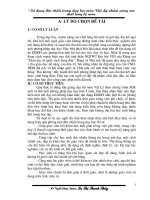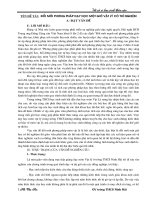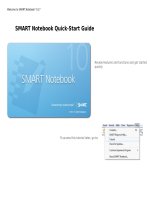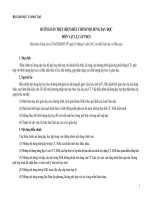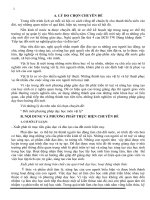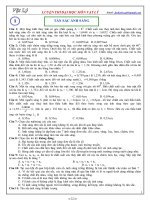Dạy học môn Vật Lý bằng tiếng Anh
Bạn đang xem bản rút gọn của tài liệu. Xem và tải ngay bản đầy đủ của tài liệu tại đây (735.68 KB, 17 trang )
<span class='text_page_counter'>(1)</span><div class='page_container' data-page=1>
EDUCATION AND TRAINING DEPARTMENT OF TRA VINH PROVINCE
<b>NGUYEN THIEN THANH HIGH SCHOOL FOR THE GIFTED</b>
<b>PHYSICAL LECTURE</b>
<b> </b>
<b>LECTURER</b>
<b> MS. Viên Tuấn Anh</b>
<b>Tra Vinh city, 2016</b>
</div>
<span class='text_page_counter'>(2)</span><div class='page_container' data-page=2>
<b>CHAPTER 2 </b>
<b>STEADY CURRENT</b>
◦
<b><sub>UNIT 7.</sub></b>
<b><sub> STEADY CURRENT</sub></b>
◦
<b><sub>UNIT 8.</sub></b>
<b><sub> ELECTRICAL ENERGY. ELECTRICAL POWER</sub></b>
◦
<b><sub>UNIT 9.</sub></b>
<b><sub> OHM’S LAW FOR THE ENTIRE CIRCUIT</sub></b>
◦
<b><sub>UNIT 10.</sub></b>
<b><sub> COMBINING POWER SUPPLIES INTO AN ADAPTER</sub></b>
◦
<b><sub>UNIT 11.</sub></b>
<b><sub> HOW TO SOLVE SOME PROBLEMS ABOUT THE </sub></b>
<b>ENTIRE CURCUIT</b>
◦
<b><sub>UNIT 12.</sub></b>
<b><sub> PRACTICE: DETERMINING THE ELECTROMOTIVE </sub></b>
</div>
<span class='text_page_counter'>(3)</span><div class='page_container' data-page=3>
<b>UNIT 8. </b>
<b>ELECTRICAL ENERGY. ELECTRICAL POWER</b>
<b>I – ELECTRIC ENERGY CONSUMPTION </b>
<b>AND ELECTRICAL POWER</b>
<b>II – POWER OF HEAT OF A CONDUCTOR </b>
<b>WHEN AN ELECTRIC CURRENT PASSES </b>
<b>THROUGH IT</b>
</div>
<span class='text_page_counter'>(4)</span><div class='page_container' data-page=4>
<b>1. Electric energy consumption of a circuit</b>
<b>I – ELECTRIC ENERGY CONSUMPTION AND </b>
<b>ELECTRICAL POWER</b>
<b>+</b>
U
<b></b>
-R
I
Figure 8.1
<b>A = Uq = UIt (8.1)</b>
<b>A : electric energy consumption of a circuit (J) </b>
<b>U : potential difference (V)</b>
<b>q : electrical charge (C)</b>
<b>I : current Intensity (A)</b>
<b>t : time (s) </b>
<i><b>The amount of electric energy that a circuit consumes when a current passes </b></i>
<i><b>through to transform into other energy forms, is measured by the work of </b></i>
<i><b>electric force when shifting charges in direction.</b></i>
</div>
<span class='text_page_counter'>(5)</span><div class='page_container' data-page=5>
<b>2. Electrical power</b>
<b>I – ELECTRIC ENERGY CONSUMPTION AND </b>
<b>ELECTRICAL POWER</b>
<b>P : electric power (W)</b>
<b>A : electric energy consumption of a circuit (J) </b>
<b>U : potential difference (V)</b>
<b>I : current Intensity (A)</b>
<b>t : time (s) </b>
Power of a circuit is the consumed power of electric energy of that circuit and
has a value equal to electrical energy that circuit consumes in a unit of time, or
equal to the product of the voltage between two ends of the circuit and current
passing through that circuit.
<b>C4. Tell units of the quantities in the formula (8.2)</b>
A
UI
(8.2)
t
</div>
<span class='text_page_counter'>(6)</span><div class='page_container' data-page=6>
<b>1. Joule – Lentz’s law</b>
<b>II – POWER OF HEAT OF A CONDUCTOR WHEN </b>
<b>AN ELECTRIC CURRENT PASSES THROUGH IT</b>
where Q : thermal energy (J)
The thermal energy radiating in a conductor is directly proportional to the
resistance of the conductor, with the square of current nad with the time that
an electric current passes through that conductor.
<b>C5. Prove that the power of heat in a conductor when an </b>
<b>electric current passes through it is calculated by the formula</b>
<b>And tell the measument units of the quantities in the formula </b>
<b>above. </b>
2
Q RI t
(8.3)
</div>
<span class='text_page_counter'>(7)</span><div class='page_container' data-page=7>
<b>2. Power of heat in a conductor when an electric current passes </b>
<b>through it</b>
Power of heat
P in a conductor when an electric current passes through it is
specific to the speed of heat radiation of that conductor and is specified by
radiated heat in that conductor in a unit of time.
<b>II – POWER OF HEAT OF A CONDUCTOR WHEN </b>
<b>AN ELECTRIC CURRENT PASSES THROUGH IT</b>
2
Q
RI
(8.4)
t
</div>
<span class='text_page_counter'>(8)</span><div class='page_container' data-page=8>
<b>1. Work of a power supply</b>
<b>III – WORK AND POWER OF A POWER SUPPLY</b>
<i>Power consumption in the entire circuit is equal to the work of strange force in the </i>
power supply. From the formula , we have the formula to calculate the
work A
<sub>ng</sub>
of the power supply
<b>2. Power of a power supply</b>
The power of a power supply is specific to the speed of work performance of that
power supply and is specified by the work of the power supply in a unit of time.
This power P
<sub>ng</sub>
is also equal to electric consumption power of the entire circuit.
ng
A
q
It
(8.5)
A
(7.3)
q
ng
ng
A
I
(8.6)
t
</div>
<span class='text_page_counter'>(9)</span><div class='page_container' data-page=9>
<b>SUMMARIZE MAIN CONTENT</b>
◦
<sub>1. Power consumption of a circuit:</sub>
◦
<sub>2. Power of a circuit:</sub>
◦
<sub>3. Joule-Lenzt’s law:</sub>
◦
<sub>4. Power of heat of a conductor:</sub>
◦
<sub>5. The work of power supply:</sub>
◦
<sub>6. The power of the power supply:</sub>
A = Uq = UIt (8.1)
A
UI
(8.2)
t
P
2
Q RI t
(8.3)
2
Q
RI
(8.4)
t
P
ng
A
q
It
(8.5)
ng
ng
A
I
(8.6)
t
</div>
<span class='text_page_counter'>(10)</span><div class='page_container' data-page=10>
Exercise 1
<b>Electric consumption is measured with:</b>
<b>Results</b>
A. A Voltmeter
B. An electricity meter
C. An ammeter
D. An electrometer
</div>
<span class='text_page_counter'>(11)</span><div class='page_container' data-page=11>
Exercise 2
<b>Which of the following units is electric power measured in?</b>
<b>Results</b>
A. Joule (J)
B. Watt (W)
C. Newton (N)
D. Coulomb (C)
</div>
<span class='text_page_counter'>(12)</span><div class='page_container' data-page=12>
Exercise 3
<b>Calculate electricity energy consumption and electric </b>
<b>power when an electric current with the intensity of 1 A </b>
<b>passes through the conductor for 1 hour, given that the </b>
<b>potential difference between two ends of this </b>
<b>conductor is 6V.</b>
Solution:
</div>
<span class='text_page_counter'>(13)</span><div class='page_container' data-page=13>
Exercise 4
<b>On the label of an electric kettle, </b>
<b>there are values of 220 V – 1000 W.</b>
<b>Solution</b>
a) Tell the meaning of numbers obove.
b) Use an electric kettle with the
voltage of 220 V to boil 2 litres of
water from the temperature of 25
0
<sub>C. </sub>
Calculate the time of boiling water,
known that the efficiency of the kettle
is 90% and the heat capacity of water
is 4190 (J/(kgK))
+ 220 V : rated level voltage
+ 1000 W : rated level power
+ Thermal energy: Q = UIt = Pt
+ Water absorbed a thermal energy:
Q
<sub>a</sub>
= mcΔt = D.V.c.(t
<sub>2</sub>
– t
<sub>1</sub>
)
= 1.2.4190.(100 – 25) = 628500 J
and, Q
<sub>a</sub>
= 0,9Q = 0,9UIt
</div>
<span class='text_page_counter'>(14)</span><div class='page_container' data-page=14>
Exercise 5
<b>A power supply has the electromotive power of </b>
<b>12 V</b>
<b>. When we connect this </b>
<b>power supply with a light bulb to make a closed circuit, it supplies an electric </b>
<b>current with the intensity of </b>
<b>0.8 A</b>
<b>. Calculate the work of this power supply </b>
<b>which has been produced in for </b>
<b>15 minutes</b>
<b> and calculate the power of the </b>
<b>power supply at that time.</b>
Solution:
</div>
<span class='text_page_counter'>(15)</span><div class='page_container' data-page=15>
Exercise 6
<b>Name an electric device or equipment for each </b>
<b>of the following cases</b>
<b>Results</b>
a) When operating, it transforms electrical energy
into thermal energy and light energy
b) When operating, it transforms the whole
electrical energy into thermal energy
c) When operating, it transforms electrical energy
into mechanical energy and thermal energy
d) When operating, it transforms electrical energy
into chemical energy and thermal energy
Bulb
Electric Cooker
Fan
</div>
<span class='text_page_counter'>(16)</span><div class='page_container' data-page=16></div>
<span class='text_page_counter'>(17)</span><div class='page_container' data-page=17>
Choose the true answer.
</div>
<!--links-->
